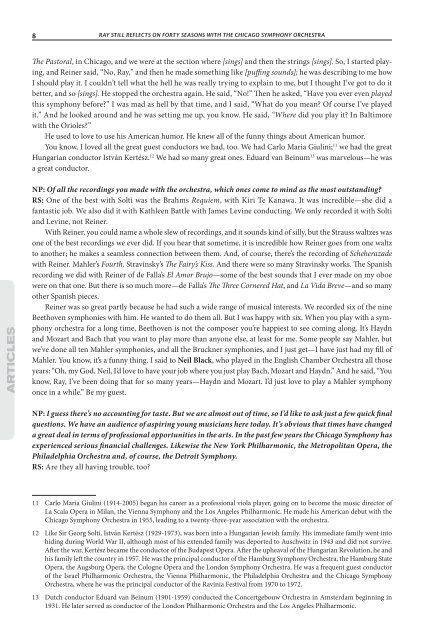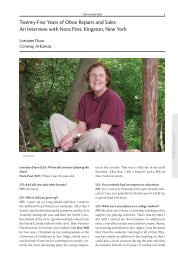Ray Still - Nora Post Inc.
Ray Still - Nora Post Inc.
Ray Still - Nora Post Inc.
Create successful ePaper yourself
Turn your PDF publications into a flip-book with our unique Google optimized e-Paper software.
ARTICLES<br />
8<br />
RAY STILL REFLECTS ON FORTY SEASONS WITH THE CHICAGO SYMPHONY ORCHESTRA<br />
The Pastoral, in Chicago, and we were at the section where [sings] and then the strings [sings]. So, I started playing,<br />
and Reiner said, “No, <strong>Ray</strong>,” and then he made something like [puffing sounds]; he was describing to me how<br />
I should play it. I couldn’t tell what the hell he was really trying to explain to me, but I thought I’ve got to do it<br />
better, and so [sings]. He stopped the orchestra again. He said, “No!” Then he asked, “Have you ever even played<br />
this symphony before?” I was mad as hell by that time, and I said, “What do you mean? Of course I’ve played<br />
it.” And he looked around and he was setting me up, you know. He said, “Where did you play it? In Baltimore<br />
with the Orioles?”<br />
He used to love to use his American humor. He knew all of the funny things about American humor.<br />
You know, I loved all the great guest conductors we had, too. We had Carlo Maria Giulini; 11 we had the great<br />
Hungarian conductor István Kertész. 12 We had so many great ones. Eduard van Beinum 13 was marvelous—he was<br />
a great conductor.<br />
NP: Of all the recordings you made with the orchestra, which ones come to mind as the most outstanding?<br />
RS: One of the best with Solti was the Brahms Requiem, with Kiri Te Kanawa. It was incredible—she did a<br />
fantastic job. We also did it with Kathleen Battle with James Levine conducting. We only recorded it with Solti<br />
and Levine, not Reiner.<br />
With Reiner, you could name a whole slew of recordings, and it sounds kind of silly, but the Strauss waltzes was<br />
one of the best recordings we ever did. If you hear that sometime, it is incredible how Reiner goes from one waltz<br />
to another; he makes a seamless connection between them. And, of course, there’s the recording of Scheherazade<br />
with Reiner. Mahler’s Fourth, Stravinsky’s The Fairy’s Kiss. And there were so many Stravinsky works. The Spanish<br />
recording we did with Reiner of de Falla’s El Amor Brujo—some of the best sounds that I ever made on my oboe<br />
were on that one. But there is so much more—de Falla’s The Three Cornered Hat, and La Vida Breve—and so many<br />
other Spanish pieces.<br />
Reiner was so great partly because he had such a wide range of musical interests. We recorded six of the nine<br />
Beethoven symphonies with him. He wanted to do them all. But I was happy with six. When you play with a symphony<br />
orchestra for a long time, Beethoven is not the composer you’re happiest to see coming along. It’s Haydn<br />
and Mozart and Bach that you want to play more than anyone else, at least for me. Some people say Mahler, but<br />
we’ve done all ten Mahler symphonies, and all the Bruckner symphonies, and I just get—I have just had my fill of<br />
Mahler. You know, it’s a funny thing. I said to Neil Black, who played in the English Chamber Orchestra all those<br />
years: “Oh, my God, Neil, I’d love to have your job where you just play Bach, Mozart and Haydn.” And he said, “You<br />
know, <strong>Ray</strong>, I’ve been doing that for so many years—Haydn and Mozart. I’d just love to play a Mahler symphony<br />
once in a while.” Be my guest.<br />
NP: I guess there’s no accounting for taste. But we are almost out of time, so I’d like to ask just a few quick final<br />
questions. We have an audience of aspiring young musicians here today. It’s obvious that times have changed<br />
a great deal in terms of professional opportunities in the arts. In the past few years the Chicago Symphony has<br />
experienced serious financial challenges. Likewise the New York Philharmonic, the Metropolitan Opera, the<br />
Philadelphia Orchestra and, of course, the Detroit Symphony.<br />
RS: Are they all having trouble, too?<br />
11 Carlo Maria Giulini (1914-2005) began his career as a professional viola player, going on to become the music director of<br />
La Scala Opera in Milan, the Vienna Symphony and the Los Angeles Philharmonic. He made his American debut with the<br />
Chicago Symphony Orchestra in 1955, leading to a twenty-three-year association with the orchestra.<br />
12 Like Sir Georg Solti, István Kertész (1929-1973), was born into a Hungarian Jewish family. His immediate family went into<br />
hiding during World War II, although most of his extended family was deported to Auschwitz in 1943 and did not survive.<br />
After the war, Kertész became the conductor of the Budapest Opera. After the upheaval of the Hungarian Revolution, he and<br />
his family left the country in 1957. He was the principal conductor of the Hamburg Symphony Orchestra, the Hamburg State<br />
Opera, the Augsburg Opera, the Cologne Opera and the London Symphony Orchestra. He was a frequent guest conductor<br />
of the Israel Philharmonic Orchestra, the Vienna Philharmonic, the Philadelphia Orchestra and the Chicago Symphony<br />
Orchestra, where he was the principal conductor of the Ravinia Festival from 1970 to 1972.<br />
13 Dutch conductor Eduard van Beinum (1901-1959) conducted the Concertgebouw Orchestra in Amsterdam beginning in<br />
1931. He later served as conductor of the London Philharmonic Orchestra and the Los Angeles Philharmonic.



